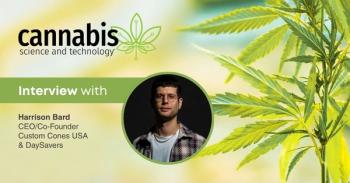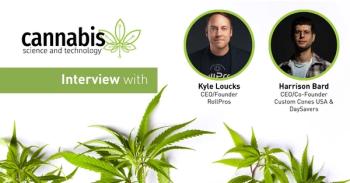
The Road to Cannabis Research: Interview with Anna Schwabe, PhD
In this interview clip from our Women in Grow: Leadership in Cannabis Genetics and Cultivation supplement, Anna Schwabe, PhD shares her educational background in plant genetics.
In our Women in Grow: Leadership in Cannabis Genetics and Cultivation supplement, Cannabis Science and Technology interviewed researcher and educator Anna Schwabe, PhD, Associate Lecture Professor at the University of Colorado and Chief Operating Officer of CannaGen, an online cannabis genetic marketplace for licensed breeders, nurseries, and cultivators.
In this video clip, Dr. Schwabe discusses her educational background and what led her to in-depth research on cannabis genetics and more.
Check out our
Transcription
Sebastian Krawiec: Hello everyone, I'm Sebastian Krawiec, Managing Editor of Cannabis Science and Technology, and we are joined today by Dr. Anna Schwabe, a leading expert in cannabis genetics and biology. Dr Schwabe holds her bachelor's, master's and doctorate's degrees from the University of Northern Colorado, where she received the Graduate Dean Citation for Excellence and the Dean's Award for Outstanding Dissertation for her research on cannabis variation. She has been published extensively on topics that include THC potency, cannabis strains, genetics, and olfactory discrimination, and is an accomplished botanical illustrator and educator. Dr. Schwabe is currently Associate Lecture Professor at the University of Colorado, where she co-developed and teaches multiple cannabis science courses and is Principal Research Director for the Agricultural Genomics Foundation. Most recently, she became Chief Operating Officer of CannaGen, an online cannabis genetic marketplace for licensed breeders, nurseries, and cultivators. Thank you so much for joining us today.
Anna Schwabe: Thanks for having me.
Krawiec: It's a pleasure. To start off, could you to tell us a little bit about your background and how you became interested in cannabis?
Schwabe: Like many people, I was introduced to cannabis in high school and again in college. My first stint was at Colorado State University and I took a lot of Drugs in the Human Body courses, my major was anatomy and physiology, so I really interested in that sort of stuff. So, there was a lot of cannabis dabbling, not necessarily partaking in, but learning about it, researching it, that kind of thing, reading books like the Electric Kool Aid Acid Test and those kind of hippie movement literature books. So that was where it started. I did not graduate from Colorado State, but I did take a lot of courses there. I took some time off and worked in the pizza industry for a while, and then after about 10, 15 years doing that, I wanted to go back to college. I finished my bachelor's degree and my emphasis was in cellular and molecular biology.
During that time, we had a new faculty member who joined UNC, and he was teaching plant systematics and all the boring plant classes that I totally didn't want to take, but the Animal Behavior class was full, so I needed an upper level biology course, and the only one that had seats left was this plant taxonomy class, Plant Systematics. I took it because otherwise I would have had to go another semester to get all the credits that I needed. So I took it and didn't particularly enjoy it – it was interesting, it was new, the professor was super young, very excited about teaching about plants. I learned a lot about all kinds of stuff, but it still wasn't my bag of things that I was super interested in, but we got to do some drawing of plants, which I really enjoyed, and that pushed me towards getting that botanical illustration certification. I also ended up having to take some capstone credits, which, if you haven't been in academia, you have to do bench work where you learn lab skills, or you do a project where you turn in a big paper or something to get you ready for the job world where you have to do more than just read books and take quizzes. So, I ended up working in Mitt’s lab – he was the professor for the systematics class. I had to do six credits of capstone work, which was quite a lot. It was like 100 hours or so in the course of a semester to graduate on that timeline that I had given myself. The project that he tasked me with was extracting DNA from cacti, and this was a project that was in collaboration with the Denver Botanic Gardens and the Bureau of Land Management, which was great. I graduated with that degree, went and got my botanical illustration certification, and then I was like, I kind of want to keep doing this. I asked Mitt if I could do my master’s and carry on that same project. So that's my background in population genetics, that started with this cactus project. So I got my master’s in that, which was looking at the hybridization of these two closely related cacti that grow in the same area. The Bureau of Land Management wanted to know, are they hybridizing? Because if they're hybridizing, then they don't really warrant protection. And I promise the story is going somewhere, it does land on cannabis.
After I graduated with my master’s, I went and worked at the Denver Botanic Gardens, working on multiple projects, looking at population and genetic relationships within and among closely related species. I started working there in 2012. In 2012 is when Colorado voted on adult use cannabis, so it was during that time that cannabis was really starting to take off in Colorado, people were getting interested. Colorado was the first state to legalize recreational use for adults, so there was a lot of conversations going on. I had a volunteer in my lab who was getting into the industry, and I thought it was really interesting. There were conversations that were popping up, there were questions that were popping up in the community among consumers, like, how come when I buy Blue Dream from this dispensary, it's not the same as when I buy it from this other dispensary? So I thought, with my background in population genetics and specifically looking at genetic relationships within and among species or groups, I had the perfect background to be able to answer some of those questions. I approached Mitt again and said, “Hey, I've got this idea.” Cannabis is newly legal. We don't know anything about it. There's really not a lot of research that has been done on it, because it's been illegal for the better part of a century, and certainly in terms of, since we've had genetic tools, and especially in terms of a marketplace and the retail arena, there really wasn't any research that had been done to answer some of these questions. Yeah, there was research on THC and what THC does to the brain, but that's not really what I was interested in, right? Mitt said, “No, we're not doing weed. This is a conservation population genetics lab.” But he did change his tune, and he was like, “You know what? This really is an interesting question, and we can build on this, and someone's going to do it. So, yeah, let's go ahead and do this.” He went to the school lawyer, the dean, the provost, and the president, and they all said, “yeah, she can totally work on cannabis, as long as she's not bringing smokeable material onto campus. Yeah, we can do that.” I just needed the DNA. Getting the DNA out of the plant and into the lab was really what I needed to do. So that's where it all started.
Updated on May 15, 2025 at 7:30PM EST to include video transcription.
Newsletter
Unlock the latest breakthroughs in cannabis science—subscribe now to get expert insights, research, and industry updates delivered to your inbox.



